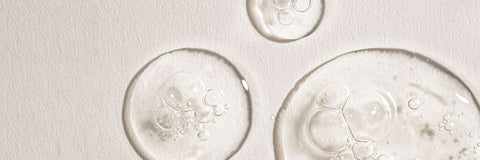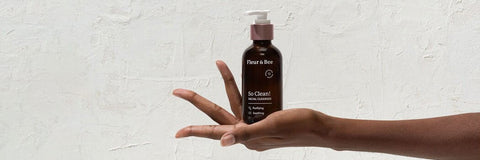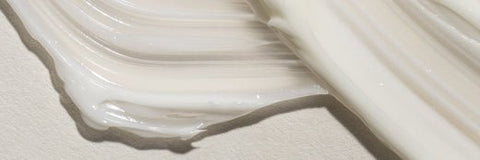Wondering why babies have such, well… baby soft skin? In the most basic terms, when we are very young, our skin naturally sheds itself every week or two, up to every 4 weeks when we are teens. Your skin renews itself, revealing fresher, brighter skin in a process we call skin cell turnover. However, as we age, this process slows down dramatically. As adults, those dead skin cells on the topmost layer of our skin aren’t too keen to take a hike without a little help. This is where exfoliation comes into play.
Exfoliation helps you remove the dead skin cells and other debris sitting on our skin, revealing newer skin underneath. It improves the appearance of skin tone and radiance, creating a fresh, revitalized glow.
For that reason, in this article, we’re going to discuss facial exfoliation, what it is, 10 benefits of exfoliation, chemical vs. physical exfoliation, how to exfoliate your skin, how to make your own exfoliator, and frequently asked questions about exfoliation.
IN A NUTSHELL
Main Takeaways: Exfoliation is the process of removing dead skin cells that have built up on the surface of the skin. It’s key in helping your skin stay smooth.
Good to Know: There are two main types of exfoliators: chemical and physical. Chemical exfoliators, such as glycolic acid, dissolve the bonds between dead skin cells, allowing them to be cleared away. Physical exfoliators, like sugar, physically remove the dead skin cells from the surface of your skin.
Recommended Products: Prince Charcoal Detox Mask.
Facial Exfoliation: What Is It?
While cleansing your skin on a daily basis may rid the skin of dirt and oil, it doesn’t necessarily act as a facial rejuvenator or help unclog pores the way exfoliation does. Exfoliation either physically or chemically (meaning, on a molecular level) removes the dead skin cells and other debris that lies on the top layer of your skin, revealing newer skin underneath.
Here are 7 Benefits of Exfoliation
- Exfoliation creates a radiant, glowing complexion. Yes, cleansing can help rid the skin of dirt and oil, but exfoliation goes deeper.
- Exfoliation helps moisturizers work more effectively. Moisturizer will not absorb into your skin if there’s a layer of dead skin blocking its path.
- Exfoliation prepares the skin for make-up. By helping to even out skin texture, exfoliation helps make-up go on as smoothly as possible.
Chemical vs. Physical Exfoliation
Exfoliation can take a few different forms, but the two main ways to exfoliate your skin is either chemical or physical exfoliation.
The main difference between chemical and physical exfoliation for skin is that chemical exfoliation uses acids to exfoliate the skin, while physical exfoliation uses some kind of material or device. This material can be anything from grains to sugar to charcoal, or even a brush or special sponge.
When speaking about chemical exfoliation, there are basically two main classifications of exfoliants.

AHAs and BHAs
AHAs are alpha-hydroxy acids found naturally in milk, fruits, and sugarcane. Mostly working on the top layer of skin, they basically exfoliate by dissolving the bonds that keep skin together. When they do, they expose beautiful new skin that imparts a natural glow. Here are some examples of AHAs:
- Glycolic acid
- Citric acid
- Lactic acid
The other main classification of exfoliants are BHAs or beta-hydroxy acids. Derived from different kinds of bark also get in the pores, unclogging them so that new skin shows through. They are just a tad stronger than AHAs.
Salicylic acid is a common and very effective BHA that works amazingly fast on skin, removing dirt and oil from pores and leaving your skin soft and ready for moisturizer.
AHAs and BHAs work very well together, making sure all layers of skin are well exfoliated, which is why you’ll frequently see them both in the same skin care products.
Finally, you may have also heard of chemical peels. Usually done at a salon or doctor’s office with a qualified specialist, chemical peels generally offer a deeper level of exfoliation and are usually much more costly than over-the-counter exfoliators. They may also take a few days to recover from and may require more after care than regular exfoliators.
Which is better? Chemical exfoliation or physical exfoliation?
The answer to this question lies mostly in what you’re trying to achieve by exfoliating your skin. If you’re looking for a surface-level exfoliation, physical exfoliation might be the way to; but if you’re looking for something a bit deeper, you might want to go with chemical exfoliation. For those with sensitive skin, chemical exfoliation is actually more gentle on the skin than physical exfoliation, which uses abrasion to remove dead skin.
Although the word “acid” may sound daunting, the kinds of acid used in chemical exfoliants are gentle and work on a molecular level to achieve the same (or better) results as physical exfoliation.
How to Exfoliate Your Face
Exfoliating your skin at home is easy. Always start by cleansing your skin with a facial cleanser, like So Clean!.
Once your skin is clean, apply a gentle exfoliant like our Prince Charcoal Detox Mask. You don’t need any special tools—just apply with your fingers in a thin but opaque layer. Prince Charcoal will not dry into a tight, flaky layer like some clay masks. We’ve formulated our detox mask to be gentle and soothing while still giving you gentle exfoliation. It uses both activated coconut charcoal, clay and glycolic acid to purify your pores and reveal smoother skin.
Leave it on for about eight-to-ten minutes while it works its magic, then simply wash it off with warm water. Now that your skin is exfoliated, don’t forget the rest of your routine! Products like serums and moisturizers are always much more effective when used on clean, well-exfoliated skin.
Keep in mind that most exfoliants that come in scrub or mask form are usually meant to be washed (or sometimes peeled) off, while most liquid exfoliants are meant to be left on.
When using a chemical exfoliant, like an AHA or BHA, it is important to always follow up with sunscreen during the day, as your newly exfoliated skin is more susceptible to photodamage.

How to Make Your Own Exfoliator
Making your own exfoliants at home is actually pretty easy. However, you should always do a test patch on your skin to make sure you’re not allergic to the ingredients you are using. Here are a few do-it-yourself recipes you can try:
Sugar Scrub
Sugar makes a great exfoliant, whether in refined or raw form. Using equal proportions of honey and sugar, apply the mixture to your skin just as you would an over-the-counter scrub. Gently massage the scrub into your skin, focusing on the areas with rough texture. This can be used on both your face and your body. Use a damp washcloth & warm water to remove the scrub, and be sure to follow up with moisturizer.
Oat Scrub
If a sugar scrub sounds a little too abrasive, try a DIY exfoliant using oats! Simply grind some dry oats in a blender or food processor and combine with a bit of oil, such as jojoba, coconut or almond oil. You can treat this mixture more like a mask, or use it as a gentle scrub.
Salt Scrub
While there are a plethora of salts available, choosing which salt to use will be up to you. We recommend taking into account how tough (or delicate) your skin is. If you’re not sure, start out with a very finely ground salt and work your way up to using a rougher, more textured salt. Combine your salt with either coconut oil or honey and use as directed above.
You can also add a few little drops of essential oil in these mixtures as well for a lovely scent and added benefits. Just be sure that the oil you are using will not irritate your skin, and avoid using oils like peppermint or eucalyptus around the eyes. You can also control how strong or gentle the scrub is by playing with the proportion of the exfoliating ingredient to the binding ingredient you’re using (e.g. switching from equal parts salt and coconut oil to ¼ salt to ¾ coconut oil).
The only real downside to a DIY exfoliant is that unfortunately, it usually won’t last all that long, so it is usually best to make them in small batches for immediate use.

Frequently Asked Questions About Exfoliation
Is exfoliation safe?
When it comes to exfoliation, everyone’s skin is different with different levels of tolerance for different products and procedures; but that said, generally speaking, exfoliation is entirely safe for skin. Exfoliation for skin is not only safe, but it helps keep skin healthy and glowing. It also helps prepare the skin to absorb moisture.
How often should I exfoliate?
Exfoliating one to three times a week should be more than enough to see and feel results. Always refer to the instructions given on the label of your exfoliating product. The best thing to do is to gradually increase the number of times a week you exfoliate and see how your skin looks and feels. The goal is healthy, glowing skin that’s ready to take in moisture, not skin that’s been rubbed raw.
Can exfoliation damage my skin?
Damage can occur when your skin is over-exfoliated, so always follow the directions on the label of any product.
A chemical procedure, like a face peel, can cause damage when not properly attended to, which is why we recommend carefully researching a reputable expert who can adjust treatment based on your skin.
Are DIY exfoliants effective?
It always depends on individual skin and what you’re using to exfoliate with, as not all DIY exfoliants are good for all skin types; but generally speaking, yes, they are very effective. That said, most need to be used fairly quickly or they could develop mold or bacteria or lose their potency, even if well preserved.
What’s the difference between chemical exfoliation and physical exfoliation?
Physical exfoliation is when you use an ingredient or a tool to exfoliate your skin (i.e. a scrub or a facial brush). Chemical exfoliation is when you use an acid, like glycolic acid, to exfoliate the skin.
How can I exfoliate naturally?
Using clean, botanical ingredients that are naturally-derived is a great way to exfoliate our skin. Our Prince Charcoal Detox Mask is a safe, natural way to exfoliate your skin.
Can I exfoliate with a washcloth?
Any tool with a little roughness can help exfoliate your skin, but honestly, it can be too rough for your skin and cause irritation.
Why do I need to exfoliate my face?
Exfoliating your skin not only renews the look of beautiful skin, it also allows the rest of your skincare routine to absorb into your skin so it is more effective. As we get older, our skin does not naturally shed its dead skin cells as quickly as it did when we were much younger, so exfoliating helps with that process.






